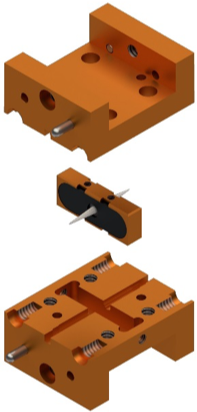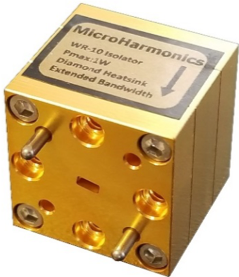Micro Harmonics has announced the availability of several high-performance millimeter wave isolators for applications requiring low insertion loss and superior isolation.
The initial standard products are available with two waveguide interfaces: WR12, covering 60 to 90 GHz, and WR10, covering 75 to 110 GHz. The full-band products work well over frequencies outside of the standard waveguide bands. Power handling exceeds the current state-of-the-art, with diamond substrates used to channel heat to the waveguide block.
Two WR12 isolators, optimized for the popular 71 to 76 GHz and 81 to 86 GHz bands, have remarkably low insertion loss: 1 dB or less, with typical isolation of 20 dB.

Drop-In Configuration
Micro Harmonics has also developed a drop-in isolator topology comprising a center plate that houses the core assembly and an E-plane split waveguide block containing a stepped waveguide twist on both input and output. This topology can be used as a stand-alone component, or the center plate can be removed and the core assembly integrated into a larger system.
Micro Harmonics will provide CAD drawings to facilitate designing the drop-in isolator into the next assembly and will reimburse the customer for returning the outer housing.
A drop-in isolator covering W-Band has typical insertion loss of 1.4 dB and 25 dB isolation.
Micro Harmonics’ ferrite isolator products were developed for use on NASA submillimeter missions requiring critical sensor and detector technology and were supported with SBIR funding. Commercial uses include scientific instrumentation such as plasma diagnostics, chemical spectroscopy, biomaterial analysis and radio astronomy.
Micro Harmonics was founded in 2008 as a research and design consultancy for microwave, millimeter wave and sub-millimeter wave components and is developing an advanced line of Faraday rotation isolators and circulators in bands from WR15 through WR3 (50 to 320 GHz). Product data sheets are available at the Micro Harmonics website.

